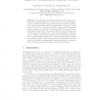Free Online Productivity Tools
i2Speak
i2Symbol
i2OCR
iTex2Img
iWeb2Print
iWeb2Shot
i2Type
iPdf2Split
iPdf2Merge
i2Bopomofo
i2Arabic
i2Style
i2Image
i2PDF
iLatex2Rtf
Sci2ools
WABI
2010
Springer
2010
Springer
Improved Orientations of Physical Networks
Abstract. The orientation of physical networks is a prime task in deciphering the signaling-regulatory circuitry of the cell. One manifestation of this computational task is as a maximum graph orientation problem, where given an undirected graph on n vertices and a collection of vertex pairs, the goal is to orient the edges of the graph so that a maximum number of pairs are connected by a directed path. We develop a novel approximation algorithm for this problem with a performance guarantee of O(log n/ log log n), improving on the current logarithmic approximation. In addition, motivated by interactions whose direction is pre-set, such as protein-DNA interactions, we extend our algorithm to handle mixed graphs, a major open problem posed by earlier work. In this setting, we show that a polylogarithmic approximation ratio is achievable under biologically-motivated assumptions on the sought paths.
Bioinformatics | Current Logarithmic Approximation | Graph Orientation Problem | Polylogarithmic Approximation Ratio | WABI 2010 |
| Added | 31 Jan 2011 |
| Updated | 31 Jan 2011 |
| Type | Journal |
| Year | 2010 |
| Where | WABI |
| Authors | Iftah Gamzu, Danny Segev, Roded Sharan |
Comments (0)

